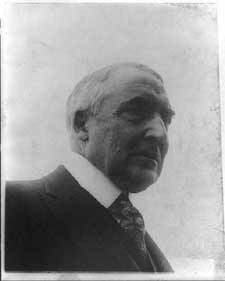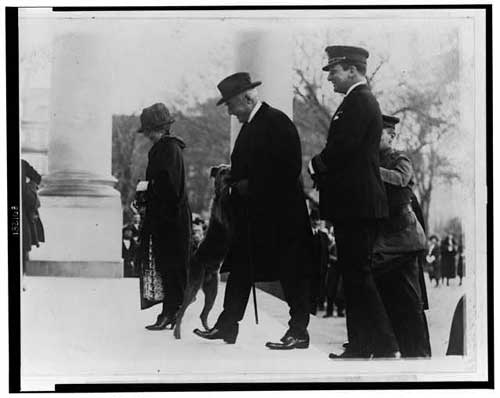 What did kill Warren G. Harding By June Allen July 23, 2003
The nation was stunned by the unexpected death! Harding was a comparatively young 58, a former newspaper owner, handsome, charming and popular in those opening years of the roaring 20s. The cause of death was first announced by doctors as a stroke, later modified as a probable heart attack. He had been feeling ill for at least a week before his death, complaining of severe stomach cramps. Then it was thought perhaps he had suffered shellfish poisoning from tainted crabs eaten on the return voyage after a long expedition through the wilds of Alaska. There was even a rumor that the bad shellfish might have been provided by irate Alaskan fishermen. The cause of his demise was simply a mystery. Was there more than met the eye in this death? There were whispers concerning the fact that a scandal of monumental proportions was about to break in the nation's capital, exposing the shenanigans of the president's cabinet officials, beginning with the Teapot Dome disgrace. His Secretary of Interior Albert B. Fall was about to be exposed (and convicted six years later) for taking a $100,000 bribe in return for a lease on the federal oil reserve near Casper, Wyoming, a scandal gone down in history as Teapot Dome. President Harding had been heard to grumble that his enemies didn't give him any trouble, it was his friends who caused him grief! And there was something else, the raised eyebrows and exchanges of knowing glances among the First Lady's acquaintances. The once-divorced Florence Kling Harding - called The Duchess behind her back - had learned that her heretofore childless second husband had not one but two mistresses as well as a baby girl by one of them. Florence Harding was an uncomfortable five years older than her attractive husband. She had been the driving force in his ambitious rise from Ohio newspaper editor to Senator from Ohio and then to President of the United States. The expedition to Alaska had been Florence's idea, the lengthy trip called by one of her biographers "the great dream of the duchess." The President was apparently happy to go along, willing to enjoy the adventure and do a little politicking along the way in anticipation of the second-term election the following year. For him, the trip would be an eat-drink-and-be-merry excursion all the way. So the Hardings set off on the rail trip to San Francisco, where they would board the U.S. Navy transport the S.S. Henderson. It was smooth sailing en route north, with card games for the men, jerky silent movies enjoyed by everyone, books to read and plenty to eat and drink, in spite of Prohibition.
President Harding and Mrs. Harding with pet dog, Laddie Boy, outside entrance to White House. In album: Warren G. Harding, v. 1, Herbert E. French, National Photo Company. National Photo Company Collection (Library of Congress). And the couple was greeted warmly in every stop along the way. The first port of call was Metlakatla where Florence was startled by accomplished Native Alaskan musicians in their bare feet playing for the presidential couple! They visited the grave of the world famous Anglican missionary, Father William Duncan. (Future President) Herbert Hoover, Harding's Secretary of Commerce, was personally interested in the call at Metlakatla. Hoover's uncle, the man who had raised him after the death of both his parents, had been an Oregon Indian agent who later traveled to Metlakatla to study Father Duncan's unique methods with the Tsimshian people. The widower uncle, John Minthorn, had married a Metlakatla woman. In Ketchikan the beaming President and dignified First Lady accepted tributes of gold and ivory jewelry. The President laid the cornerstone of the Masonic Temple, on the site now occupied by the Ketchikan State Building on Main Street. The July 8 call at Ketchikan was described by the sophisticated presidential national press corp as notable for "hillsides of wooden homes decorated with Independence Day bunting and misspelled signs." At Wrangell, canoes paddled by Native Alaskans in colorful blankets glided out to the ship, welcoming the presidential party. The Hardings and guests spent three hours ashore there, seeing the sights. 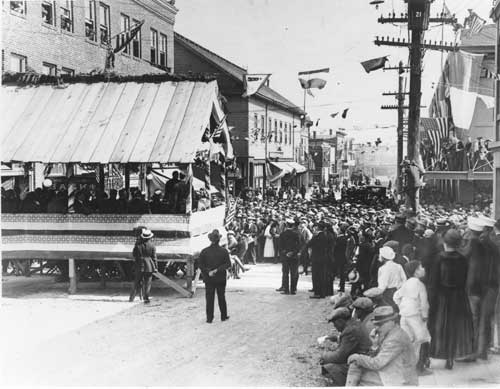 July 8, 1923 New York Times Photo, courtesy Tongass Historical Society At Juneau, the visitors' sightseeing was guided by Alaska Governor Scott C. Bone, who had earlier joined the party at its arrival in Southeastern. Gov. Bone had been appointed to the Alaska governorship by his friend President Harding three years before. The governor is remembered primarily for delivering the dedication address at the Alaska Agricultural College - now the University of Alaska Fairbanks - at its opening in September of 1922, and of making the decision in 1925 that relay dog teams would be the fastest mode of travel to deliver the diphtheria serum to Nome in 1925, an act memorialized in today's Iditarod Race. Gov. Bone formally entertained the Hardings at the governor's mansion, complete with 500 guests and an outdoor dance. But it was Juneau's Sunday Capital editor Will Steel who may have zeroed in on the President's mode of governance as well as his marriage when he wrote, "The president freely expressed himself on matters of state and politics, with frequent observations on the part of the first lady of the land, whose mind is always alert and particularly keen on matters that concern her husband and his administration." In short, Mrs. Harding was definitely the woman behind the man behind the Presidential Seal. Privately, and not so privately, the President and his wife argued and battled the whole way north. Harding was a reportedly quite genial man but with Mrs. Harding always on watch. When they arrived in Seward July 13, they boarded the Presidential car. [The Pullman car was recently refurbished and is open to the public at Fairbanks' Pioneer Park, formerly called Alaskaland]. During the lengthy train trip on the new railroad, the President was happy to engage his cronies in poker games. Mrs. Harding, however, had special-ordered a steel-wheeled Dodge roadster, modified to run on rails, where she sat alone to enjoy the magnificent Alaska scenery as they traveled north! For company, she called on James G. Steese, chairman and president of the federally owned Alaska Railroad. She mentioned to him the President's heart condition, that he was not well. 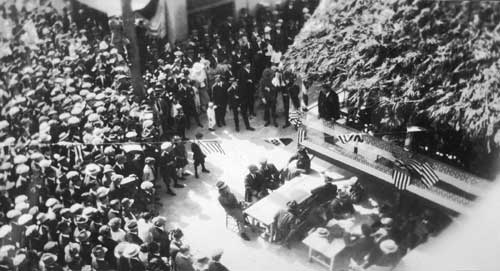 Ketchikan, Alaska Donor: Doris Bordine, Courtesy Ketchikan Museums From Wasilla to Willow the President himself drove the train while the First Lady sat in the fireman's seat. But after yet another quarrel she retired to the baggage car. These particular miles from Wasilla to Willow were the reason why the railroad had been built in the first place - the rich gold strikes in the mountain chain along the route that needed transport to saltwater. As the train traveled north it entered coal-rich territory, another rich product of Alaska's mining wealth. At Nenana the President drove the golden spike that - ritually - connected the two ends of the railroad that reached it northern terminus in Fairbanks, itself a center for a still gold-producing region. From Fairbanks - where it was reported that Mrs. Harding had suffered a bout of exhaustion - the presidential party headed south for Seward via the era's automobiles, along the Richardson Highway. It must have been a miserably long trip on a primitive road. It surely appalled the First Lady. The travelers boarded the Henderson in Seward July 17. They crossed over for a stop at Cordova, and continued on to Sitka where they stopped on July 23 for a festive celebration. A combined Navy, Alaska Native Brotherhood and Firemen's Band greeted and tootled a welcome to Sitka by the Sea. The party visited the Sheldon Jackson museum and school, St. Michael's Cathedral and the agricultural experiment station. That afternoon the visitors reboarded the ship. It was shortly after that the troubles began. The touring party members had been eating shellfish during the entire sea voyage, going and coming. But it was two days out of Sitka that the President first complained of sharp abdominal pains, but suffered no vomiting. Shellfish was suspected. But in hindsight no one could remember how the crabs had been delivered or by whom. And no one else became ill although many of the party had eaten crab. When the ship docked at Vancouver B.C., the President managed to address a crowd of some 40,000 well-wishers, but he was still feeling weak and ill. More problems were to arise. The following morning the Handerson's boiler room flooded and as all hands were called to action, the passengers too ran on just deck in time to see the big transport ram a smaller ship that sank in the fog. The President was said to have lost his good nature and was heard to say, "I hope this boat sinks." On departing after a stop in Seattle, the ill-fated Henderson rammed another vessel. It was not a pleasant voyage south! By the time the ship reached San Francisco, the President was seriously ill. By that time it was evident that the planned continuation of the voyage through the Panama Canal and on to Puerto Rico would have to be postponed and possibly cancelled. The Hardings retired to the hotel to await the outcome of the President's illness. 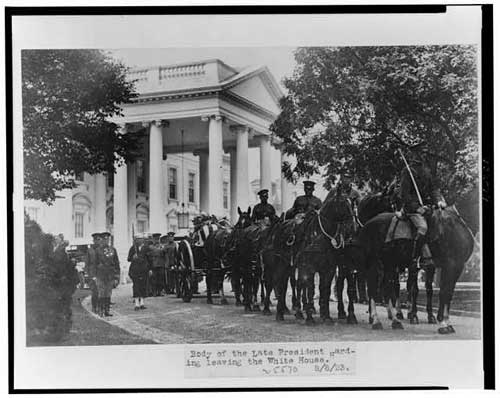 Funeral cortege for President Harding with the north portico entrance to the White House in the background. In album: Warren G. Harding, Herbert E. French, National Photo Company, v. 2, p. 52, no. 25570. Courtesy Library of Congress Mrs. Harding accompanied her husband's body back to Washington D.C. She immediately went into seclusion and died the following year at the age of 64. She had been a faithful wife and she felt great rage and grief over her husband's infidelities. But she was courageous - the first wife of a president to fly in an airplane. She adored and courted Hollywood celebrities as well as the rich and famous. She loved her position as First Lady. She did not live to see the 1927 publication of the best seller "The President's Daughter" by Nan Britton, the story of the young woman's seven-year affair with Harding and the birth of their daughter, a book dedicated to "all unwed mothers." The love letters of Harding and his other paramour, Carrie Phillips, are sealed by the Library of Congress and by court order may not be opened until the year 2014. But it is Mrs. Harding, the Duchess, who in death has the satisfaction of lying beside her husband in Harding Memorial Park in Marion, Ohio, the wife of a President of the United States.
june@sitnews.org Copyright © 2003 June Allen All rights reserved. Not to be reprinted in any form without the written permission of June Allen.
|
||||||||
